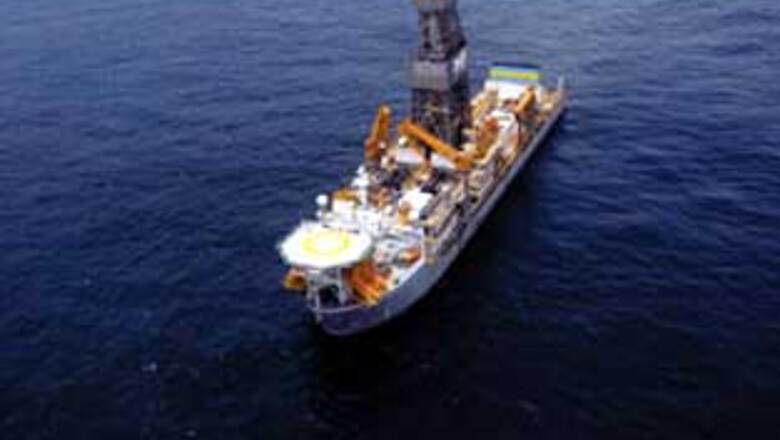
views
It was one of those moments that make oil exploration in the deep seas such an unpredictable business. Early in September, a team of engineers from Oil and Natural Gas Corporation (ONGC) and its contractor TransOcean, the world's largest offshore drilling company, watched in horror as a live camera feed showed mud gushing out vertically from a well they had been drilling for the past 35 days. The feed, captured by a remotely operated vehicle two kilometres below the water surface, showed that something was drastically wrong. The blowout preventor, an essential piece of equipment on every oil well that regulates pressure to ensure safety, had failed.
Drilling had to stop immediately.
As Forbes India goes to print, the entire top brass of ONGC is sweating it out. They are monitoring developments at KK-4CA, the well off the Konkan Kerala coast, which in many ways represents the company's biggest bet in recent times. At $700,000 a day, the drill-ship Dhirubhai Deepwater KG1, being used to drill it has been hired from arch-rival Reliance Industries (RIL). Guided by satellites to keep its position in choppy seas, it was scheduled to drill two wells costing Rs. 500 crore each in the ultra-deep waters in the Kerala-Konkan basin. As of now, it is not known how much time it will take to restart work. Till that happens, ONGC will bleed $200,000 every day. Its drilling schedule will go off kilter, an event that could prove to be much more expensive in the long run.
The decision in Kerala-Konkan was contrarian to start with. While the rest of the world looks for gas and oil in the very prolific Krishna-Godavari and Cauveri basins on the east coast of India, ONGC is looking West. The quest is to open a brand new oil-frontier in India. The geologists are looking for a basin which is a receptacle for sediments from a pre-historic river system flowing out through what they call the Palghat gap, a space in the Western Ghats between Tamil Nadu and Kerala formed millions of years ago. ONGC thinks this paleo-delta, created out of the river that extends hundreds of miles into the sea, could be a huge yet undiscovered entrapment for hydrocarbons.
The decision was made after pouring over seismic data from thousands of kilometres of India's offshore coastline. ONGC's offshore exploration and development chief S.C. Rao is unequivocal, "This is our best chance," he says. His team are convinced that the maturity of the source rock and the cap make a `wonderful combination' that would hold a very substantial reserve. Their resolve has been backed fully by the ONGC board.
PAGE_BREAK
The company is to drill two wells at what the geologists believe are the most prospective locations in the block. The first well is targeting a depth of 6,500 meters below the seabed, and KG1 that began drilling on August 1, has now reached half this depth. The drill bit was just about to penetrate the first target horizon (called fan A) when the BOP failed. When drilling restarts, samples will be drawn from the fans to show if ONGC is on the right track. These will be taken for evaluation from three such fans throughout September, by which time it will be known whether there is any oil or gas. The ship will then move to start drilling the second well in the region.
Slippery Terrain
For oilmen, Kerala-Konkan is not a new dream. Many have chased it and failed. The geology has attracted all manner of oil explorers since the 1970s. About 15 wells have been drilled, but, mostly in the shallow waters. Among those who have tried their unsucessfully luck include Shell, BHP, ONGC and most recently RIL.
Why then is ONGC taking such a step? For one, without a big find it runs a serious risk of being overtaken by rival Reliance Industries in terms of gas production in less than a year. On the oil front too, newer challengers like Cairn India could threaten its position as the country's dominant energy producer. Pressure is also mounting from the government as well as the Director General of Hydrocarbons (DGH), the upstream regulator who monitors commitments made by oil companies. "What ONGC needs not just another discovery, but to open a new basin - a new frontier like Bombay High in the 70s and the Krishna-Godavari that was opened by RIL in 2003,'' says Mehul Thanawala vice-president, JM Financial. A basin, would be a new area of operation where many subsequent discoveries can later be expected.
ONGC exploration director D.K. Pande says despite all the activity by others in Kerala-Konkan, the area where they are now drilling is completely unexplored. "Only one deep water well has been drilled in Kerala Konkan before, and it was in a completely different region where we had reservoirs without shale. To ensure a reservoir and a trap, we need a combination of sand and shale. These conditions exist in the areas where we're drilling," he says.
Critics within and outside ONGC say the company was made a scapegoat to accommodate RIL. Hit by poor margins in its refining and petrochemical business, RIL had decided by the end of 2008 to put exploration on the backburner and focus on production from its gas-rich fields at KG. It did not need the rigs that it had earlier contracted from TransOcean for five years and offered them to ONGC. The result is that ONGC has sub-leased the rig from RIL paying it a hefty day-rate. Many of these arguments fall flat because the industry knows that ONGC had been looking for rigs for the past three years. Desperate to complete its commitments to the government, the company was at one time willing to offer a profit-share in return for a deepwater rig. Several of its exploration and development projects, even where oil and gas were already discovered were delayed because of the lack of rigs. With the new rig it drew detailed plans to drill 18 wells over the next two years. Most would be in deep and ultra-deep waters.
PAGE_BREAK

In that sense, ONGC seems to be following another national oil heavyweight. Brazil's national oil company, Petrobras has made a series of stunning offshore finds, in offshore Brazil, a region that is emerging as the new El Dorado for the energy industry. More recently, British oil major BP has announced a large oil find ten kilometres beneath the sea in the Gulf of Mexico, the biggest in the US in the past three years. This adds credence to the theory that most of the undiscovered oil in the world will be found deeper in the seas.
Oil in Water
Deepwater drilling has become the new mantra for large oil companies. Most companies are flush with funds made in the oil bubble last year and demand is high. Yet, others in the industry are wary of ONGC's attempts to drill in the KK block now. Oil refining company Hindustan Petroleum (HPCL) is ONGC's partner on the block, with a 20 per cent stake. Sources in the DGH say HPCL has written to the regulator expressing dissatisfaction over the amount of homework that ONGC has done in KK before deciding to drill. HPCL officials declined to comment on the issue. ONGC officers say there was no dissent on the decision, as HPCL were signatories to the resolutions that endorsed the drilling. Given the kind of investment that it entails, about 700 km of three-dimensional seismic data has been acquired in addition to other surveys and this is way beyond the minimum required work that was required to be done, says ONGC general manager G.K. Prasad.
"Despite pressure from other regions where a drillship was needed, we've consciously chosen to drill in the KK blocks first. It is a well-thought out programme'', says Rao. The company didn't depend entirely on its own judgement and hired Australian advisor RPS Energy, to study the initial reports. RPS confirmed their assessment and so did another independent consultant, he says. Physical evidence came from satellite aperture radar (SAR) pictures, showing likely crude oil seepages close to the block. Of course the only way to be sure was to actually go in and drill.
With work stopping because of the BOP failure, the voices against ONGC will only get louder. If ONGC is lucky, they will be able to repair the drill onsite itself. If not, the contractor TransOcean may have to take the ship all the way to Korea or even Houston. Since the extent of the problem is not clear, there is no timeframe by which drilling can resume. ONGC will not have to pay the $500,000 it does now for the drill. But, they will have to continue to bear $200,000 per day in additional costs for hiring other services like well-logging, cementing and helicopters till they get the ship back. It will also be very difficult for find another drillship, as they are in short supply all over the world.
Deepwater drilling is not everyone's cup of tea, says Narendra Taneja, oil expert and commentator from Upstream magazine. Ambitious plans for exploring the deep should not be approached in a piecemeal manner like a 100-day project. It has to be well thought out, wider, more sustained campaign. Though ONGC has a good experience, it could do well to go with someone like Petrobras, who is already producing from such wells, he says.
ONGC director of drilling, U.N. Bose, says, they have drilled over 50 wells in depths of over 3,000 metres, and are among the handful of operators in the world with experience to deal with the difficulties. His confidence will be severely tested with the current problems. Subir Raha was ONGC's boss when the company last looked at the Kerala Konkan deep waters as part of its $1.8bn deep-water exploration project ‘Sagar Samridhi', India's first concerted effort to map the deep waters on both coasts. "The attraction was the huge reservoir, but unfortunately we could not locate where the entrapment was," he says. All they found then were dry holes.
Raha says the oil industry is no stranger to dry holes. The story of the American geologist, from US company Standard Oil of California (SoCal), wildcatting in Saudi Arabia in 1938 is probably the most quoted in the oil business. He drilled six wells over four years all of which turned out to be dry. Fast running out of cash, he had just enough to stake it all on the seventh, which turned out to be a gusher. There was no looking back. The desert kingdom today has the world's largest recoverable crude oil reserves, nearly 260 billion barrels. They still preserve well #1 at the Aramco museum, a reminder that sometimes one has to risk it all.
The guys at ONGC would sure give their right arms and more to be in Aramco's shoes.




















Comments
0 comment